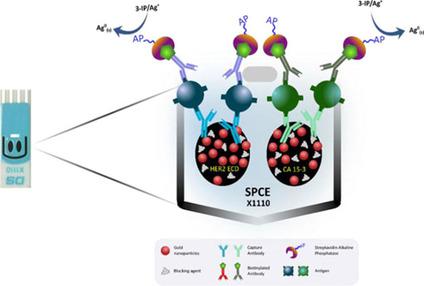当前位置:
X-MOL 学术
›
Electroanalysis
›
论文详情
Our official English website, www.x-mol.net, welcomes your feedback! (Note: you will need to create a separate account there.)
Electrochemical Biosensing in Cancer Diagnostics and Follow‐up
Electroanalysis ( IF 3 ) Pub Date : 2018-04-30 , DOI: 10.1002/elan.201800193 Maria Freitas 1 , Henri P. A. Nouws 1 , Cristina Delerue-Matos 1
Electroanalysis ( IF 3 ) Pub Date : 2018-04-30 , DOI: 10.1002/elan.201800193 Maria Freitas 1 , Henri P. A. Nouws 1 , Cristina Delerue-Matos 1
Affiliation

|
In cancer, screening and early detection are critical for the success of the patient's treatment and to increase the survival rate. The development of analytical tools for non‐invasive detection, through the analysis of cancer biomarkers, is imperative for disease diagnosis, treatment and follow‐up. Tumour biomarkers refer to substances or processes that, in clinical settings, are indicative of the presence of cancer in the body. These biomarkers can be detected using biosensors, that, because of their fast, accurate and point of care applicability, are prominent alternatives to the traditional methods. Moreover, the constant innovations in the biosensing field improve the determination of normal and/or elevated levels of tumour biomarkers in patients’ biological fluids (such as serum, plasma, whole blood, urine, etc.). Although several biomarkers (DNA, RNA, proteins, cells) are known, the detection of proteins and circulating tumour cells (CTCs) are the most commonly reported due to their approval as tumour biomarkers by the specialized entities and commonly accepted for diagnosis by medical and clinical teams. Therefore, electrochemical immunosensors and cytosensors are vastly described in this review, because of their fast, simple and accurate detection, the low sample volumes required, and the excellent limits of detection obtained. The biosensing strategies reported for the six most commonly diagnosed cancers (lung, breast, colorectal, prostate, liver and stomach) are summarized and the distinct phases of the sensors’ constructions (surface modification, antibody immobilization, immunochemical interactions, detection approach) and applications are discussed.
中文翻译:

电化学生物传感在癌症诊断和随访中的应用
在癌症中,筛查和早期发现对于患者治疗的成功和提高生存率至关重要。通过分析癌症生物标记物,开发用于非侵入式检测的分析工具,对于疾病的诊断,治疗和随访至关重要。肿瘤生物标志物是指在临床环境中指示体内癌症存在的物质或过程。可以使用生物传感器检测这些生物标志物,因为它们具有快速,准确和即时的适用性,是传统方法的重要替代方案。此外,生物传感领域的不断创新改善了对患者生物体液(例如血清,血浆,全血,尿液等)中正常和/或升高水平的肿瘤生物标记物的测定。尽管已知几种生物标记(DNA,RNA,蛋白质,细胞),但蛋白质和循环肿瘤细胞(CTC)的检测是最常报道的,这是因为它们被专业机构批准为肿瘤生物标记,并被医学和医学领域的诊断所接受。临床团队。因此,本篇综述对电化学免疫传感器和细胞传感器进行了广泛描述,因为它们具有快速,简单和准确的检测,所需的样品量少以及获得的出色检测限。总结了针对六种最常诊断的癌症(肺癌,乳腺癌,结直肠癌,前列腺癌,肝癌和胃癌)报告的生物传感策略,并概述了传感器构造的不同阶段(表面修饰,抗体固定,免疫化学相互作用,检测方法)和应用讨论。
更新日期:2018-04-30
中文翻译:

电化学生物传感在癌症诊断和随访中的应用
在癌症中,筛查和早期发现对于患者治疗的成功和提高生存率至关重要。通过分析癌症生物标记物,开发用于非侵入式检测的分析工具,对于疾病的诊断,治疗和随访至关重要。肿瘤生物标志物是指在临床环境中指示体内癌症存在的物质或过程。可以使用生物传感器检测这些生物标志物,因为它们具有快速,准确和即时的适用性,是传统方法的重要替代方案。此外,生物传感领域的不断创新改善了对患者生物体液(例如血清,血浆,全血,尿液等)中正常和/或升高水平的肿瘤生物标记物的测定。尽管已知几种生物标记(DNA,RNA,蛋白质,细胞),但蛋白质和循环肿瘤细胞(CTC)的检测是最常报道的,这是因为它们被专业机构批准为肿瘤生物标记,并被医学和医学领域的诊断所接受。临床团队。因此,本篇综述对电化学免疫传感器和细胞传感器进行了广泛描述,因为它们具有快速,简单和准确的检测,所需的样品量少以及获得的出色检测限。总结了针对六种最常诊断的癌症(肺癌,乳腺癌,结直肠癌,前列腺癌,肝癌和胃癌)报告的生物传感策略,并概述了传感器构造的不同阶段(表面修饰,抗体固定,免疫化学相互作用,检测方法)和应用讨论。



























 京公网安备 11010802027423号
京公网安备 11010802027423号